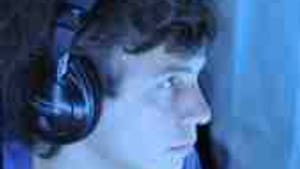Stay in the Loop
BSR publishes on a weekly schedule, with an email newsletter every Wednesday and Thursday morning. There’s no paywall, and subscribing is always free.
Flights of underwater imagination
"WHaLE OPTICS' by Thaddeus Phillips

One of the recurring delights of Philadelphia's Live Arts Festival has been the opportunity it affords to experience the acute curiosity of the natural and political worlds, and the unpredictable flights of imagination that Thaddeus Phillips brings to his multi-media theatrical productions. Phillips marries an almost nerdish fascination with the metrics that define our existence with a non-linear whimsy that doesn't take too seriously the serious issues at the heart of his (usually) one-man productions.
In WHaLE OPTICS, Phillips breaks new ground as an artist, flexing his director and designer chops to infuse a diverse and highly talented ensemble of performers with his intent of finding meaning in an absurd world through humor and wonderment. With two initiating sources— Carl Sagan's chapter on humpback whales in Cosmos, and an image of an isolated fiber-optics station in Avalon, New Jersey that connects our phones and the Internet to Europe and beyond— Phillips weaves territories stretching from the ocean depths and Antarctica to the far-off universe, and stretching in time from the Alexandria Library of ancient Egypt to the present and the Voyager 77 speeding 16 billion years from the sun.
Phillips's curiosity and imagination are boundless, yet he deftly structures his points. We and the whales communicate across thousands of miles of underwater ocean, linking our seemingly disparate, mammalian lives. But the fall of the dice of natural selection causes the sounds within our east-west fiber optic-cables to obstruct the north-south sounds emitted by the whales.
Tapes vs. books
The work's most compelling themes concern the quest for communication and love. A composer, Toshi (Makoto Hirano), seeking communion with whale songs, also communicates long-distance via tape recordings with a librarian, Hypatia (Emily Letts), who in turn sends him her love via the Old World technology of the printed word, in selected books about whales.
The poignancy of the sole caretaker manning the oceanside fiber-optics station (Brian Osborne)— whose passive desk job is interrupted only by a daily call from his elderly institutionalized mother, a UPS Internet sale delivery, and a video of a Carl Sagan PBS broadcast— is heightened by the presence in his workspace of the transatlantic cables transmitting the conversations of 61 million people.
Osborne ably embodies the Chaplinesque world-weariness and presence of a latent spark seeking a different life—an issue Phillips addressed last year in his one-man Fringe Festival production ¡El Conquistador! Later Osborne performs a masterful transformation as an idealistic, prophetic Carl Sagan who slowly backs into the ocean waters on stage (a seascape created with brilliant brevity by a simple rolling up of pants legs).
Mysterious swimmer
Phillips's methods of play and experimentation brought out the depths of talent within a cast that performed multiple roles. Lee Ann Etzold stood out memorably as a mysterious, muscled, sensuous swimmer, a saucy German dive shop gal, and the UPS delivery-woman who launches a courtship with Roger thanks to a Groupon at a Red Lobster (of course). James Ijames convincingly portrays a haughty scientist, a non-verbal dive shop assistant who can initiate songs from the whales, and a docile Red Lobster waiter.
Emily Letts, a recent graduate of the Headlong Institute, brought verve to her bespectacled librarian character. Hirano was our audience conduit to the underworld of whales— his earphones listening to their songs were ours, as was his final descent into those waters. The Colombian-born Juan Gabriel Turbay offered a fitting array of percussive and electronic sounds without overwhelming the songs of the whales.
The only performer not listed in the program's cast list was Carl Sagan, who intermittently appeared on two video screens during the performance as a sort of stock charismatic public intellectual. There was a surreal theatricality to his handsome, wide-eyed, pronouncements along antic seashores and before images of nebulae, and in his recounting of whale songs that could be ended one month and resumed on the next note a month later.
The sunny radiance of Sagan's video presence contrasted with the cold, dark watery depths of the final scene of the whales at Antarctica. By the close, though, the audience accepted both.
In WHaLE OPTICS, Phillips breaks new ground as an artist, flexing his director and designer chops to infuse a diverse and highly talented ensemble of performers with his intent of finding meaning in an absurd world through humor and wonderment. With two initiating sources— Carl Sagan's chapter on humpback whales in Cosmos, and an image of an isolated fiber-optics station in Avalon, New Jersey that connects our phones and the Internet to Europe and beyond— Phillips weaves territories stretching from the ocean depths and Antarctica to the far-off universe, and stretching in time from the Alexandria Library of ancient Egypt to the present and the Voyager 77 speeding 16 billion years from the sun.
Phillips's curiosity and imagination are boundless, yet he deftly structures his points. We and the whales communicate across thousands of miles of underwater ocean, linking our seemingly disparate, mammalian lives. But the fall of the dice of natural selection causes the sounds within our east-west fiber optic-cables to obstruct the north-south sounds emitted by the whales.
Tapes vs. books
The work's most compelling themes concern the quest for communication and love. A composer, Toshi (Makoto Hirano), seeking communion with whale songs, also communicates long-distance via tape recordings with a librarian, Hypatia (Emily Letts), who in turn sends him her love via the Old World technology of the printed word, in selected books about whales.
The poignancy of the sole caretaker manning the oceanside fiber-optics station (Brian Osborne)— whose passive desk job is interrupted only by a daily call from his elderly institutionalized mother, a UPS Internet sale delivery, and a video of a Carl Sagan PBS broadcast— is heightened by the presence in his workspace of the transatlantic cables transmitting the conversations of 61 million people.
Osborne ably embodies the Chaplinesque world-weariness and presence of a latent spark seeking a different life—an issue Phillips addressed last year in his one-man Fringe Festival production ¡El Conquistador! Later Osborne performs a masterful transformation as an idealistic, prophetic Carl Sagan who slowly backs into the ocean waters on stage (a seascape created with brilliant brevity by a simple rolling up of pants legs).
Mysterious swimmer
Phillips's methods of play and experimentation brought out the depths of talent within a cast that performed multiple roles. Lee Ann Etzold stood out memorably as a mysterious, muscled, sensuous swimmer, a saucy German dive shop gal, and the UPS delivery-woman who launches a courtship with Roger thanks to a Groupon at a Red Lobster (of course). James Ijames convincingly portrays a haughty scientist, a non-verbal dive shop assistant who can initiate songs from the whales, and a docile Red Lobster waiter.
Emily Letts, a recent graduate of the Headlong Institute, brought verve to her bespectacled librarian character. Hirano was our audience conduit to the underworld of whales— his earphones listening to their songs were ours, as was his final descent into those waters. The Colombian-born Juan Gabriel Turbay offered a fitting array of percussive and electronic sounds without overwhelming the songs of the whales.
The only performer not listed in the program's cast list was Carl Sagan, who intermittently appeared on two video screens during the performance as a sort of stock charismatic public intellectual. There was a surreal theatricality to his handsome, wide-eyed, pronouncements along antic seashores and before images of nebulae, and in his recounting of whale songs that could be ended one month and resumed on the next note a month later.
The sunny radiance of Sagan's video presence contrasted with the cold, dark watery depths of the final scene of the whales at Antarctica. By the close, though, the audience accepted both.
What, When, Where
WHaLE OPTICS. Conceived and directed by Thaddeus Phillips. Lucidity Suitcase International production for Live Arts Festival, Sept. 1-11, 2011, at Prince Music Theater, 1412 Chestnut St. (215) 413-1318 or ticketing.theatrealliance.org.
Sign up for our newsletter
All of the week's new articles, all in one place. Sign up for the free weekly BSR newsletters, and don't miss a conversation.

 Jonathan M. Stein
Jonathan M. Stein